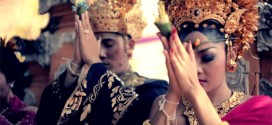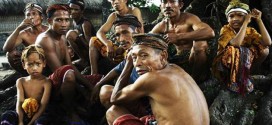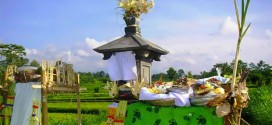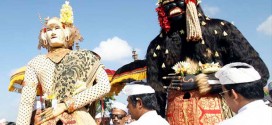
“Coconuts are indeed inseparable from the lives of those in the tropics, especially in Bali. Each of its parts, starting from the fruit, leaves, and trunk, is useful for various needs in daily activities…”
Coconuts are indeed inseparable from the lives of those in the tropics, especially in Bali. Locals largely utilise parts of the plant for various needs, starting from the fruit, leaves, and trunk. The Balinese have different names for each stage of the coconut fruit’s development with each different function. The smallest fruit that are around 2 or 3 cm in diameter are called bungsil. Village children use bungsil as simple toys. They attach rubber bands to one end and spin it on the ground then raise it ’til it springs like a spinning top as the children cheer on.
When the bungsil develops further into the stage that it contains water, it is referred to as bungkak. Religiously, bungkak is considered a fruit that contains holy water. No wonder that many are used in cleansing rituals by sprinkling its water on offerings or places to be ‘purified’.
The Bungkak soon enlarges and contains fleshy layers. This is then called klungah. But the newly formed flesh is still very juvenile and smooth like jelly but sometimes klungah can still be used for purification purposes. Pregnant women are urged to consume the fruit at this stage during their third trimester. The liquid is believed to help ‘cleanse’ the foetus from the fatty foetal layers that envelop it, making for a lighter skin complexion.
But the coconut water that is consumed is the air kelapa muda or yeh kuud. The fruit is called kuud when the flesh is thick but still soft. The water of the fruit at this stage is the most flavourful, as it quenches thirst and prevents dehydration as it is rich in electrolytes. It is also believed to be able to neutralize toxins and provide good cholesterol for the body.

Coconut water can also be fermented to produce a beverage called tuak. This is a type of alcoholic beverage that is popular across the Nusantara archipelago. When the flesh has hardened, the ripe coconuts are referred to as nyuh. The nyuh is best for grated coconut and also processed for cooking oil by mixing it with water. As the coconut milk is squeezed out, the leftover shreds or usam can still be used for polishing parquet to make it shine.
Before the palm oil industry grew into its current giant form, the Indonesian people were using coconut oil produced from household and cottage industries. The oil making process has a by-product in the form of telengis that can be prepared for consumption. Pesan telengis or telengis leftover shreds that are wrapped in banana leaves and then roasted are a delicacy and can be found in traditional markets.
These ripe ones are also widely used in religious ceremonies. It is peeled from the fibre then made into daksina. Daksina symbolizes the oneness of God and acts as a witness in rituals. It can be placed in the shrine or offering places such as pejati or sesajen.
Usually the coconuts are used first as sesajen offerings, and then after the ritual concludes they will be used in the kitchen.
It is good to note that each part of the coconut can be used. Thus when the flesh is taken for coconut milk or santan, the shell can still be used for utensils such as plates or rice ladles. The fibre can also be weaved and made into doormats.

Not only does the fruit have many names at each of its developmental stages, the leaves also get their names depending on the color phase. The young yellow leaves that grow at the top are called busung in Balinese or janur in Indonesian, and the more mature green ones are called slepan.
The yellow of the busung give it the impression of softness and exclusivity. Busung are used for ketupat rice cake weavings, decorations, penjor bamboo pole ornamentations and canang flower offering frames that are later topped off with colorful flowers. The slepan is used as the offering’s base, as the harder texture makes it withstand longer storage.
The green coconut leaves can be woven and used as roofing. The weavings are called klangsah. Since many came to use in tiles and metal roofing, the woven roofings are only reserved for very simple housing or small rice field shelter boxes.
Dried coconut leaves aren’t hastily disposed of as the spines can still be collected for flexible and highly effective brooms.
The fruit stems or danyuh can be used for various handicrafts or simply as fuel for cooking fires. Although currently the Indonesian government has aggressively urged the people to use LPG gas stoves, many still cook using fire stoves.
The coconut tree trunks are of high economical value also. Since the early days they have been used for building material and recently the majority used in knockdown gazebos that are exported overseas.
Due to its multifunctional properties, the coconut is highly regarded among the people. The Javanese consider it as the symbol of knowledge while the Balinese consider it the symbol of life and fertility.
With the progress of ages, many traditional tools have now been replaced by metallic or plastic items. Yet this does not necessarily replace the overall functions of the coconut. It still remains important and has a special place in the hearts of the local community.




